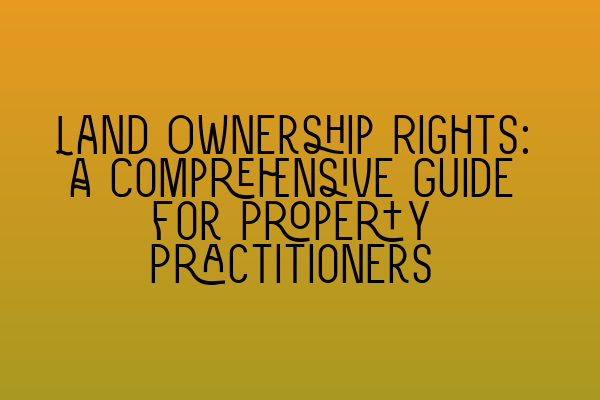Land Ownership Rights: A Comprehensive Guide for Property Practitioners
As a property practitioner, understanding land ownership rights is essential for effectively advising your clients and handling property transactions. This comprehensive guide will provide you with the knowledge and insights needed to navigate the complex world of land ownership.
1. The Basics of Land Ownership
Land ownership encompasses the legal rights and responsibilities associated with owning and possessing land. It gives individuals or entities certain entitlements, including the right to occupy, use, transfer, and exclude others from the land.
To get a deeper understanding of land ownership and to test your knowledge, you can check out our SQE 1 Practice Exam Questions and SQE 1 Practice Mocks FLK1 FLK2 articles.
2. Types of Land Ownership
There are various types of land ownership, including:
- Freehold: This is the highest form of land ownership, where the land is owned indefinitely and without limitations.
- Leasehold: In leasehold ownership, the owner holds the land for a fixed period under a lease agreement.
- Joint Tenancy: Joint tenancy occurs when two or more individuals co-own a property with equal shares and rights of survivorship.
- Tenancy in Common: Tenancy in common is a form of co-ownership where each owner holds distinct shares and can pass on their share through inheritance.
If you’re interested in learning more about different types of land ownership, our SQE 2 Preparation Courses and SQE 1 Preparation Courses can dive deeper into the subject.
3. Legal Framework for Land Ownership
The legal framework governing land ownership varies depending on the jurisdiction. In England and Wales, it is primarily based on common law, statutes, and regulations, including the Law of Property Act 1925 and the Land Registration Act 2002.
To stay up to date with the latest SRA SQE Exam Dates and land ownership laws, make sure to check out our SRA SQE Exam Dates article.
4. Land Registration
Land registration is the process of officially recording the ownership and interests in land. It provides certainty and protection for landowners, prevents disputes, and facilitates property transactions.
5. Restrictive Covenants
Restrictive covenants are agreements that impose certain limitations on the use or development of land. These covenants may have been created through contractual agreements or may be binding due to statutory provisions or historic rights.
6. Easements and Rights of Way
Easements and rights of way allow individuals or entities to use or access another person’s land for specific purposes. Understanding the creation, termination, and implications of easements and rights of way is crucial for property practitioners.
7. Adverse Possession
Adverse possession is a legal principle that allows someone who has used someone else’s land without permission to claim ownership of that land after a period of time. Property practitioners must be familiar with the requirements and limitations of adverse possession claims.
Remember, having a comprehensive understanding of land ownership rights will make you a valuable asset to your clients and enable you to navigate the complexities of property law with confidence.
If you have any questions or would like to further enhance your understanding, please don’t hesitate to contact our team at SQE Property Law & Land Law.
Disclaimer: This article is for informational purposes only and should not be considered legal advice. Consult with a qualified property law professional for specific questions and guidance.
